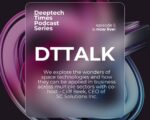In Malaysia, smart farming that runs with automated data collection and analysis is making a difference to not just improved production but also the shoring up of food security.
The innovative use case is yet another example of digitalisation driving dramatic change in the country and the larger Southeast Asian region, according to CelcomDigi, the Malaysia-based telecom operator and service provider.
The cloud and the data it holds are still the foundation for a lot of today’s innovations, including the much-talked about generative AI, said Richard Im, head of cloud and data analytics at CelcomDigi.
Deeptech Times sat down with Im on the sidelines of the Malaysian CIO Network (MCION) Conference held in Penang to gather his views on emerging deep tech, how enterprises can harness generative and voice AI for competitive advantage and customer experience; alongside the use of space technology and analytics in solving real-world problems, and what CIOs and IT leaders have to consider when deploying deep tech.
NOTE: Responses have been edited for clarity and style.
What do you understand by the term deep tech? How do you keep up with the pace of technology today?
Coming from a technology and telco background, we collaborate with a lot of different partners and a lot of different technologies – some are what they call high tech, some are deep tech as you call it.
But basically, we’re looking for technology that’s going to have high impact to our customers today in terms of the use case, and that varies across cloud, IoT and AI that are coming forward, and lots of different technologies. But in terms of the term “deep tech”, this is something that is still new for us, I guess, in terms of understanding.
Generative AI is all the rage these days. Have you considered deploying Gen AI to sharpen CelcomDigi’s edge against the competition?
We’re doing it today, actually. As you can see, my portfolio also includes data analytics and AI. So this year we’ve been very busy working with our partners in generative AI as well as conversational AI, use cases using local voice AI. All different kinds of use cases to take it to the market, specifically around improving the customer experience.
Think of people who are interacting with companies that have a lot of challenges calling for customer service. So, we’re trying to improve the customer service and to find different ways to interact in terms of different channels, different ways of communicating.
We’re trying to change the whole journey of customer interaction and conversation, and we are in the process of launching new products out there.
What are your top technology priorities for 2023 and beyond? Can deep tech help you achieve those priorities?
I think the foundation is still cloud because the infrastructure has to be digitised. It has to be there. So without the infrastructure, the network and cloud infrastructure, it’s very hard to do anything on top of that. So, we are focused on that.
On top of that is really the data management. So, once you have the data and applications in the cloud, it’s about how we manage them, how we use those insights to help our customers.
We’re moving higher up the value chain in terms of data, insights, customer insights. One example is smart farming.
We recently rolled out smart poultry, smart farming solutions where we have been gathering a lot of these data. This kind of manual data collection into the cloud – we are now automating it and we are using analytics and AI capabilities to give insights on the supply of chicken and food security.
Obviously, there are a lot of different use cases and industries we can get into, but we have started on the journey already.
Space technology is another burgeoning area within the deep tech universe. Would you consider deploying space technology for CelcomDigi in the near future?
Right now, it’s more about coverage, like how we can have more reach and more coverage in remote areas. But I think that conversation will quickly go into phone coverage, like what else we can do in terms of the reach. It could be applications, It could be a different kind of digital services.
For example, remote edge in banking is very important. How do we have the space tech to reach these people? To have to applications in a customer centre as a basic in our banking services and potentially other kinds of services on top. We are heading towards that. So I think definitely we are open for discussion, but it’s still very early days. I think.
What advice would you give fellow CIOs or IT directors on deploying deep tech for their organisations?
There are numerous things to consider. First, you have to understand your customers and understand how the technology can help them, whether it’s deep tech or other type or form.
How does technology help them? And then, we have to work out the underlying technology – what is the underlying technology and who is going to provide that capability?
Is that us or is it going to be, you know, a strategic capability you have to develop as a CIO? Or is a partner going to do that, and how do you take it to market?
So, there’s a lot of thinking of what technology can help, what capabilities do I need to build versus partners’ capabilities, and how do I take it to market as quickly as possible.











